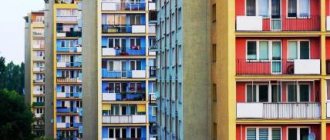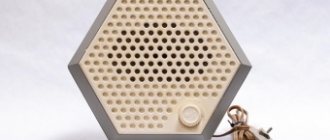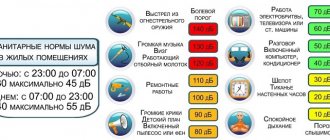Housing and communal services
7
The cost of utilities is growing every year, including for the heat supplied to our batteries. Sometimes the temperature in the apartment does not reach a comfortable level. And residents of apartment buildings complain that they are forced to overpay for a resource that does not meet heating season standards.
What should be the heating temperature of the air during the heating season and the standard temperature in the apartment according to the law? We need to understand this issue.
Air temperature standards for the heating season in an apartment 2021
The main legislative act regulating temperature standards in premises is GOST 30494-2011. “Residential and public buildings. Indoor microclimate parameters" .
They stipulate the optimal and permissible temperature standards used for apartment buildings and various premises:
- kindergartens;
- administrative buildings.
It follows from the document that the standard temperature in the apartment should be from +18°C to +24°C .
| Period of the year | The name of a room | Air temperature, °C | |
| optimal | acceptable | ||
| Winter | Living room | 20-22 | 18-24 (20-24) |
| At the temperature of the coldest five-day period: -31 °C and below | 21-23 | 20-24 (22-24) | |
| Kitchen | 19-21 | 18-26 | |
| Toilet | 19-21 | 18-26 | |
| Bathroom, combined toilet | 24-26 | 18-26 | |
| Facilities for recreation and study sessions | 20-22 | 18-24 | |
| Inter-apartment corridor | 18-20 | 16-22 | |
| Lobby, staircase | 16-18 | 14-20 | |
| Storerooms | 16-18 | 12-22 | |
| Summer | Living room | 22-25 | 20-28 |
In brackets is the indoor temperature for nursing homes and families with disabled people.
Air exchange rate
Air temperature is not the only parameter that directly affects the comfort and safety of people living in the house. Air exchange is important for the body: the presence of fresh air, ventilation of residential and non-residential premises.
This parameter is also regulated by SanPiN regulations. Thus, the required air exchange rate for a living space with an area of 18 m² is 3 m³/h per square meter, for a kitchen - three times more.
Air exchange rate is a characteristic determined by the ratio of air removed or supplied from a room per hour to the volume of this room.
Normal temperature in a corner apartment during the heating season
The new GOST does not say anything about houses with corner apartments; accordingly, the value is taken according to the standards of a standard living room. In the old GOST R 51617-2000 it was indicated that the value increases by 2 degrees.
Download the new GOST 30494-2011, current for 2021.
Deviations from the norm are allowed:
- for optimal - 2 °C;
- for permissible - 3 °C;
Violation by utility services that underestimate the heat supply to apartments entails both administrative and criminal liability.
What is the responsibility of utility companies?
The degree of responsibility of the management company depends on the severity of the offense and the consequences.
If utility companies immediately respond to a complaint and eliminate violations, there will be no consequences. When residents have to involve government authorities, punishment is inevitable. The easiest thing is administrative liability, a fine.
If the owners have damaged property or suffered health damage, they can associate this with the low temperature of the house and there is an evidence base for this, then civil proceedings and compensation for damage cannot be avoided.
When the consequences are serious, sanctions are possible, including criminal ones.
How to measure the air temperature in an apartment?
It is not very easy to obtain objective figures for the measurements taken, but if you wish, you can be patient and eventually achieve a recalculation of the heat payment.
To measure the air temperature in a room correctly, you need to adhere to a number of rules:
Measurements are taken at outside temperatures not exceeding -5°C.
Take measurements on a cloudy day. The rays of the sun, penetrating into the room through the window, additionally warm it up, and the readings on the device will not correspond to the actual picture.
Prevent heat leakage through unsealed windows and cracks.
Measure the temperature:
- in a private house - in two rooms of more than 5 sq.m., having 2 external walls or a large window (an area of 30% of all walls in the room);
- in an apartment building - measurements are taken on the first and last floors, in two rooms of more than 5 sq.m.
The measuring device should be located at a distance of at least half a meter from the outer wall and battery, at a height from the floor in rooms located mainly:
- in a sitting position - 10; 60 and 170 cm;
- standing or walking - 10; 110 and 170 cm.
Real causes of discomfort in residential premises
The air in houses and apartments may not warm up to a comfortable level due to:
- Worn elements of the heating system.
It is no secret that most heat-generating equipment, heating mains and intra-house networks have been in operation for decades, designed and installed back in Soviet times.Boiler room equipment is worn out and has low efficiency.
Coolant leaks and heat losses due to the quality of thermal insulation are recorded on pipelines.
Wiring in buildings is no better:
- air vents do not work,
there is scale and dirt in the pipes,
- Problems with setting up and operating heat supply systems.
Often, even modern heat generating equipment installed by private utility providers is not maintained to the required level.This is due to the qualifications of the service personnel - there are simply not enough professional operators of complex modern equipment.
Another problem is the desire of equipment owners to obtain excess profits by issuing maximum amounts in bills to consumers, but reducing their own costs, including for energy resources and equipment operation.
- Approved, at the design stage and installation of heating systems, errors (find out the heating wiring diagram from the boiler in the apartment on this page).
In addition to erroneous decisions, the source of problems can also be the difference in standards adopted during development and construction.The content of current regulatory documents does not always coincide with those that were relevant during the construction of houses in previous years.
As a result, a situation arises where the utility provider meets regulatory requirements, but this is not enough to obtain the required temperature in older buildings, and residents are forced to purchase oil-fired electric heating radiators with a thermostat.
- Illegal changes in intra-house networks heat supply (see examples of heating system layout in a private house here) produced by consumers.
Users independently make changes to the configuration of heating systems, and some of them may negatively affect the heat supply of their neighbors.Examples of such “improvements” are:
- removing or installing thermostats (how it works for heated floors is written here) without bypass in single-pipe systems,
increasing the area of radiators,
- changing the configuration of heating devices inside the apartment,
- Unsatisfactory energy efficiency of buildings .
The thermal insulation of old buildings is worn out, in new ones they use thermal insulation materials of inadequate quality, or, in an attempt to save on construction, they completely ignore energy efficiency requirements. - The consumer's own mistakes .
The heat transfer of heating devices is reduced due to incorrectly configured thermostats, lack of means for removing air pockets in radiators, etc.
- reducing the internal cross-section and, accordingly, the intensity of coolant flow.
- increasing heat loss.
If the temperature in the apartment is below normal, what should you do?
If during the measurements a deviation from the norm was found to be smaller, it is necessary to notify the utility service or management company that services the apartment building. She sends an emergency team to draw up a measurement report. This is an official document containing a number of details, on the basis of which a decision is made to recalculate utility bills for services. It is drawn up in two copies, one of which remains in the hands of the tenant.
If there is a significant deviation from the norm, the management company is obliged to recalculate heating payments for the month in which these deviations were discovered.
The law establishes payment reduction figures - they amount to 0.15% per hour when a temperature deviation from the standard value is detected.
For example. During the heating season, the air temperature in the corner room is fixed at 16 °C (the norm is +20 °C) 14 hours from the design period (it is 720 hours). After taking readings from an individual metering device, the thermal energy consumption for the past month amounted to 0.7 Gcal at a tariff of 1,900 rubles. 32 kopecks for 1 Gcal. Since the air temperature was below normal, the amount of payment for heating is reduced by 0.15% for each hour when it is recorded in the act.
Recalculation of utility bills for heating
- The fee for 14 hours when heating was provided of inadequate quality is reduced by: 0.15% x 14 hours = 2.1%.
- Standard payment for heat in the billing period (30 days or 720 hours): 0.8 Gcal multiplied by the tariff of 1,900 rubles. 32 kopecks total 1,520 rub. 25 kopecks
- As a result, after the reduction we get: 1,520 rubles. 25 kopecks x (100% - 2.1%) = 1,488 rubles. 32 kopecks
There are cases when patient residents measure their temperature for several days and during this period it constantly falls short of the norm. Then the fee reduction becomes significant. But not every management company is ready to unquestioningly recalculate the cost of heating services. Often, dissatisfied tenants can only defend their rights in court.
Arbitrage practice
Judicial practice on issues of compliance with temperature conditions and heating in apartment buildings is quite extensive and contains answers to key questions, failure to comply with which will entail a refusal to satisfy the subscriber’s requirements.
For example, in the Decision of January 24, 2021 in case No. 2-278/2017, the court refused to satisfy the subscriber’s requirements for recalculation due to the fact that all measurements taken, attached as evidence of exceeding permissible temperature standards, were compiled by the subscriber independently. Moreover, the subscriber in every possible way prevented representatives of the management organization from entering his apartment and did not allow them to take measurements.
But in the Ruling of the Supreme Arbitration Court of the Russian Federation dated April 11, 2012 No. VAS-3355/12 in case No. A03-1052/2011 on the refusal to transfer the case to the Presidium of the Supreme Arbitration Court of the Russian Federation, the court satisfied and collected from the homeowners’ association the debt for the supplied thermal energy for heating on the basis of , that the resource supply company provided documents indicating that inconsistencies in the temperature conditions in individual apartments were identified in the network, which is the operational responsibility of the homeowners association. In addition, no evidence was provided to show that there were clear reasons for the temperature deviation.
If the apartment is too cold, you need to contact utility services.
If they don’t react, then the regulatory authorities will. You may receive compensation for services of poor quality. Useful article? Rate and share with friends!
Problems with the heating system
Such problems, as they say, lie on the surface. Their consequence is not only barely warm radiators, but also increased humidity due to freezing and thawing of the walls. This inevitably leads to the formation of fungus. Of course, such conditions are far from normal for living. Typical signs of heating problems:
- small leak in the radiator,
- noise and bubbling in pipes,
- difference in radiator temperature within one apartment,
- heat distribution is uneven across the floors of the house,
- problems in the apartment building system as a whole.
When preparing apartment buildings for the heating season, the management company is obliged to check all systems. If any of them fails, then a number of actions must be taken to eliminate it.
When can I file a complaint?
If utility services do their work in bad faith, the quality of housing and communal services provided decreases, and temperature standards in the apartment are not observed. Any citizen has the right to file a formal complaint in the following cases:
- when the temperature in the living rooms of the apartment is less than the required norm;
- if in one calendar month the heating was turned off for a total of more than 24 hours;
- if one-time heating outages lasting more than 15 hours occur at street temperatures below 12 degrees.
Hot doesn't mean good
High temperature in the house often leads to a decrease in air humidity in the room, which has an adverse effect on human health:
- promotes the development of pathogenic microbes and ensures their spread;
- leads to drying of the mucous surface of the nasopharynx and an increased likelihood of microbes entering the body;
- moisture is removed from the circulatory system, which causes thickening of the blood, increases the load on the heart, increases blood pressure - as a result, the risk of stroke increases;
- There is an increased secretion of sweat, which disrupts the body's water balance.
Change at your discretion
In the absence of individual apartment heating or a house boiler room, it is hardly possible to influence the quality parameters of the coolant, so you should pay attention to other factors that influence the temperature.
When choosing an apartment to buy, evaluate its location in order to reduce heat loss in winter and overheating in summer. Install windows made using new technologies. Increase the number of radiators by installing thermostats or taps on each of them. Insulate the enclosing structures.
It's cold too
It is difficult to call the optimal temperature in an apartment the one at which a person begins to feel the urge to crawl under the covers or dress warmer. Low digital climate indicators for a long time negatively affect the health and mental state of residents. Excessive heat loss occurs, which is fraught with the development of colds, viral and respiratory diseases.
Before the heating season, you can use economical quartz heaters. The high melting point of quartz sand allows for strong heating of the panel.










